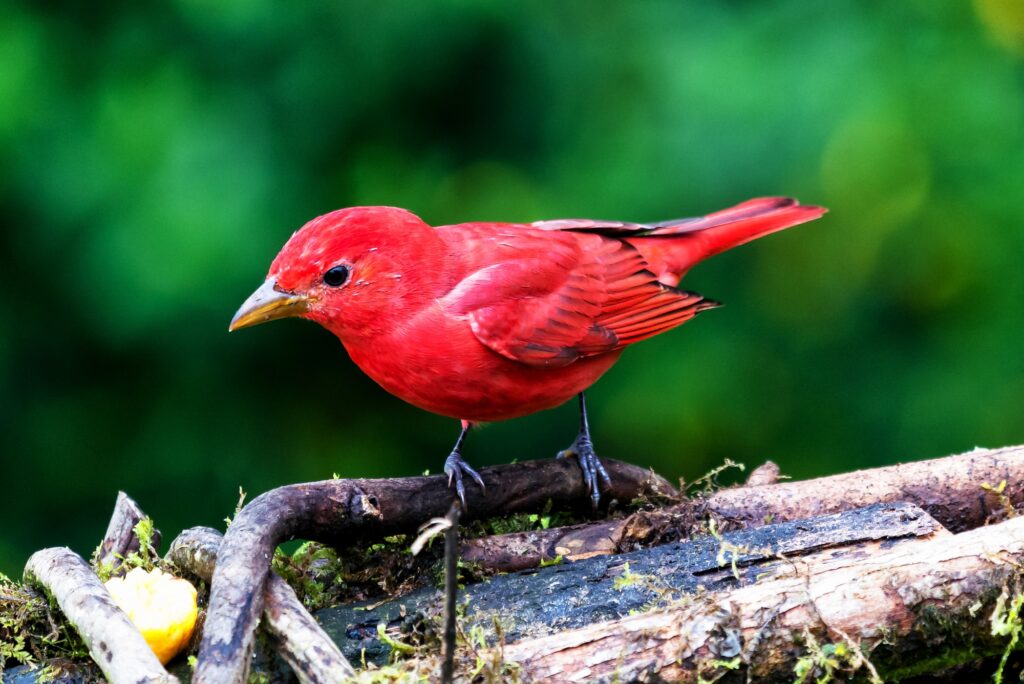Despite being the third smallest state in the Union, the Constitution State boasts an impressive collection of birds. According to state records and the Connecticut Ornithological Association, 448 bird species that are accepted by the Avian Records Committee of Connecticut (ARCC) live in the state.
Regardless of where you are, bird songs echo throughout the year. According to the same sources, a lucky birder can easily come across about 290 bird species in one year.
If you want to know more about the types of birds in Connecticut, keep reading. In this article, we’ll walk you through some of the most impressive birds of the state, arranged by color. All of them should be on every basic bird checklist. So without further ado, let’s jump right in!
Red Birds in Connecticut
Northern Cardinal

- Scientific Name: Cardinalis cardinalis
- Length: 8.3 to 9.1 inches
- Weight: 1.5 to 1.7 ounces
- Wingspan: 8.9 to 12.2 inches
The Northern Cardinal males are colorful birds known for their brilliantly red bodies as well as the red feather crown on their heads. The female wears dull colors. They are average body size but have very light body weight.
They can be found in open lands. They feed on berries from trees and will eat from a bird feeding station filled with sunflower seeds and safflower seeds. They are common backyard birds.
Summer Tanager

- Scientific Name: Piranga rubra
- Length: 6.1 to 6.9 inches
- Weight: 0.8 to 1.1 ounce
- Wingspan: 11.1 to 11.9 inches
The summer tanagers are little songbirds that are known for their mostly red-colored body and head with a tinge of orange in their underbellies. Average males weigh less than one pound.
They also belong to the family of cardinals, sharing characteristics of feather color and vocalization.
You can attract them to your backyard bird feeders by offering their favorite foods: oranges, grape jelly, suet, or mealworms.
Red-Headed Woodpecker

- Scientific Name: Melanerpes erythrocephalus
- Length: 7.5 to 9.8 inches
- Weight: 2.0 to 3.4 ounces
- Wingspan: 15.9 to 16.7 inches
Although they’re not entirely red, the red-headed woodpecker has brilliant red feathers all over its head, which is the characteristic feature of this bird and makes it identifiable among other common woodpeckers in the state. They’re medium-sized birds with white bellies and black bodies.
Their diet is a bit varied. They use their bills to make holes in tree trunks to find food and they will eat anything from seeds and insects to other small birds.
House Finch

- Scientific Name: Haemorhous mexicanus
- Length: 4.9 to 6.1 inches
- Weight: 0.6 to 0.9 ounces
- Wingspan: 8.1 to 10.5 inches
House finches are another common species in Connecticut. These brown birds are known for the rosy red color around their breasts and faces.
However, you should keep in mind that only males are red. Females wear less attractive shades of brown and gray. The degree of brightness of the red color depends mainly on the bird’s diet.
Northern Flicker

- Scientific Name: Colaptes auratus
- Length: 10.9 to 13.8 inches
- Weight: 3.1 to 5.9 ounces
- Wingspan: 17.8 to 21.2 inches
The Northern Flicker, also known as the Common Flicker, is a medium-sized bird that belongs to the bird family of woodpeckers. These birds have black marks on their backs and wings, with a distinctive red patch on their neck that makes them stand out when they land in your backyard.
One of the things that make the Northern Flicker unique is its diet. This bird forages using its long tongues to feed on insect larvae from colonies’ nests. They build their nests in deep woods.
Beware of the noise they make because they bang on man-made objects as a way to mark their territory.
Red-Bellied Woodpecker
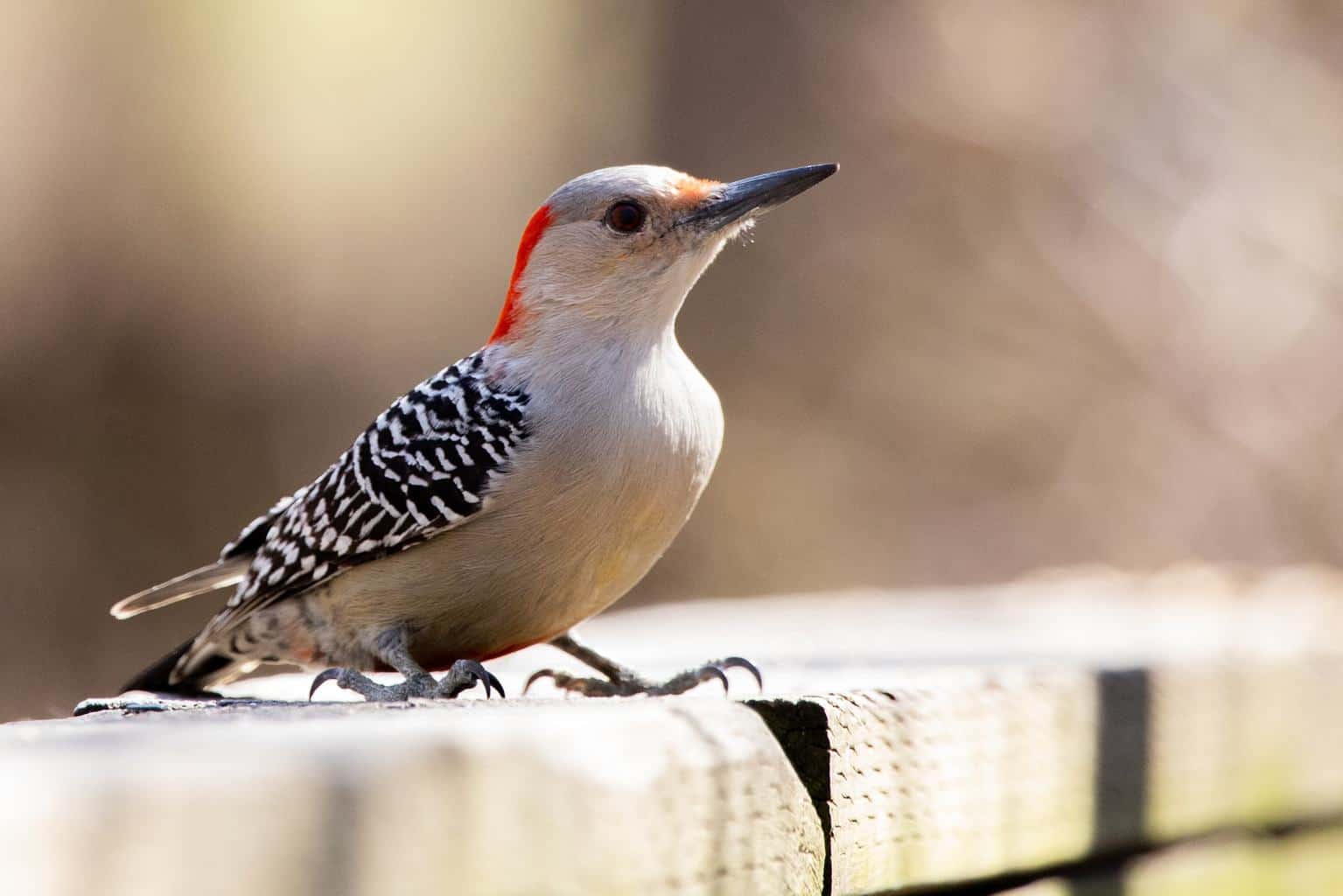
- Scientific Name: Melanerpes carolinus
- Length: 9.2 to 10.3 inches
- Weight: 2.2 to 3.2 ounces
- Wingspan: 15.7 to 17.8 inches
As the name suggests these woodpeckers are known for having shades of red on the back of their heads as well as tints of red on their bellies and faces. they also have a stiff tail which they use to help prop them up against tree trunks. They are not easily confused with their cousins, Pileated Woodpeckers.
While they prefer mature forests, you can spot them around your property banging away at the bark of trees and feeding on any size insects, or catching small fish near ponds all over New England.
Blue Birds in Connecticut
Blue Jay

- Scientific Name: Cyanocitta cristata
- Length: 8.6 to 11.8 inches
- Weight: 2.5 to 3.5 ounces
- Wingspan: 13.3 to 16.9 inches
Blue Jays are among the most beautiful birds found in Connecticut. They have a crested head and ample tail. Their bodies display a vibrant blue color. However, this color is due to the structure of their feathers and light reflecting off of them rather than pigments.
They love acorns and these beautiful backyard birds hang around bird feeders for insects and seeds.
Barn Swallow

- Scientific Name: Hirundo rustica
- Length: 6.7 to 7.5 inches
- Weight: 0.56 to 0.78 ounces
- Wingspan: 12.6 to 13.6 inches
Barn swallows are one of the most common blue-colored birds in North America. They’re known for the steely blue-colored feathers around their tail, back, and wings.
You can spot these small-sized birds perching on communication poles, in meadows, and open fields, feeding on bees, beetles, ants, and cracked eggshells.
Blue-Winged Teal
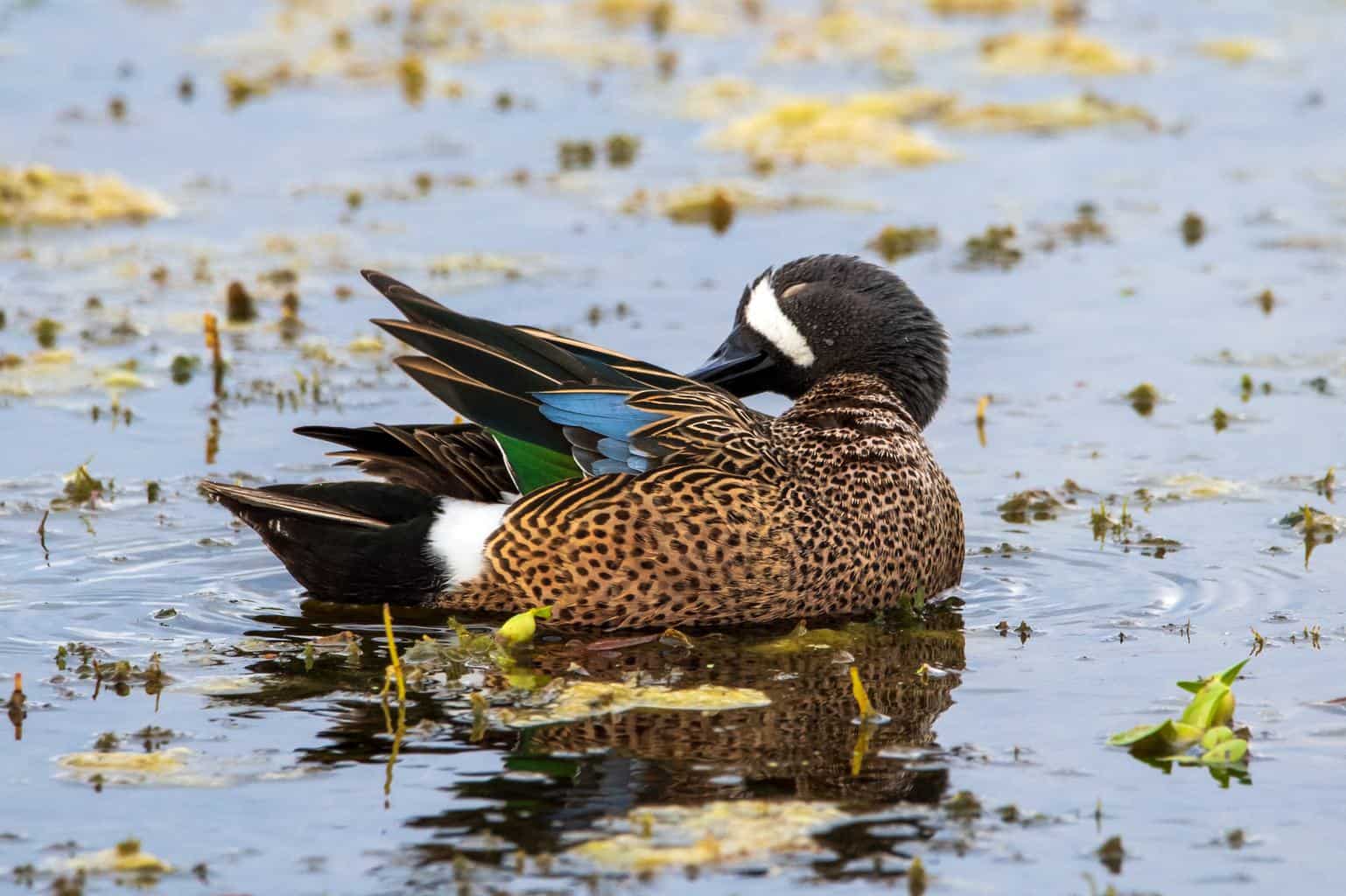
- Scientific Name: Spatula discors
- Length: 15.8 to 16.3 inches
- Weight: 13.5 to 15.4 ounces
- Wingspan: 22 to 24 inches
The Blue-winged teal is one of the less common birds in Connecticut, as they’re more likely to be found in the south. However, you can still find them in pairs during their peak breeding season in April, especially around ponds.
They have brown chests with black spots and blue bills and wings, which are their distinguishing feature.
Eastern Bluebird

- Scientific Name: Sialia sialis
- Length: 6.3 to 8.3 inches
- Weight: 0.9 to 1.2 ounces
- Wingspan: 9.8 to 12.6 inches
Half of the Eastern Bluebird is brown while the other is a deep, vivid blue. Of course, your eye will always notice the vibrant blue color first, making it extremely easy to identify the majestic little bird.
You can find them perching on telephone wires and flying around green fields in Connecticut foraging for mealworms, which you can also use to attract the bluebirds to your feeder.
Indigo Bunting

- Scientific Name: Passerina cyanea
- Length: 4.5 to 5.9 inches
- Weight: 0.4 to 0.6 ounces
- Wingspan: 7.0 to 9.0 inches
- Additional Information:
Both male and female Indigo Buntings are blue. However, the males have more vibrant colors and are entirely blue, while the females only have shades and plumage of blue on their chests.
Indigo Buntings are quite small, stocky songbirds that aren’t only easy to identify by sight, but also by their songs and calls.
Green Birds in Connecticut
Monk Parakeet

- Scientific Name: Myiopsitta monachus
- Length: 9.8 to 11.4 inches
- Weight: 3.2 to 4.25 ounces
- Wingspan: 18.8 to 19.2 inches
There are plenty of wild Quaker parrots that were accidentally introduced to Connecticut, also known as Monk Parakeets. This beautiful bird species is banned as a pet in the state due to its agricultural threat.
The birds are quite large and have bright green beautiful plumage all over their backs and heads with some blue feathers at the digit level of the wings.
What separates them from green parakeets (which aren’t found in Connecticut) is that they have white bellies.
Broad-Billed Hummingbird

- Scientific Name: Cynanthus latirostris
- Length: 3.1 to 3.9 inches
- Weight: 0.11 to 0.14 ounces
- Wingspan: 5.1 to 5.6 inches
Broad-billed hummingbirds are one of the most unique species of bird because of their iridescent green plumage, which shines vividly and brilliantly from certain angles. They differentiate from the adult ruby-throated hummingbird in coloration.
Although these beloved birds have tinges of blue, this small-sized bird shows mostly green when they spread their feathers.
The beautiful hovering birds aren’t permanent residents of the state, so they are quite rare, but extremely rewarding to spot during hummingbird season.
Green Heron

- Scientific Name: Butorides virescens
- Length: 16 to 18 inches
- Weight: 8.3 to 8.7 ounces
- Wingspan: 25.2 to 26.8 inches
Green herons are medium-large wading birds that are rather common in the state of Connecticut. The birds are usually found in swamps and marshes in search of food, from spring to late fall.
However, the loss and damage of marshes have resulted in a significant decline in the numbers of green herons in Connecticut since the late 20th century.
Orange Birds in Connecticut
Baltimore Oriole

- Scientific Name: Icterus galbula
- Length: 5.8 to 7.8 inches
- Weight: 2.3 to 3.5 ounces
- Wingspan: 3.5 to 4.7 inches
Baltimore Orioles are medium-sized passerines that are named after the color of the coat of arms of Lord Baltimore, which is orange in color. Bird Watchers will find them perching in deciduous forests.
In males, the orange plumage covers their rump as well as the underparts and the shoulder patch, with the rest of the body being pitch black with white markings and peaks.
The females may range from yellowish orange to a deep flaming orange similar to the male’s colors but lacking the black hood and back.
American Robin
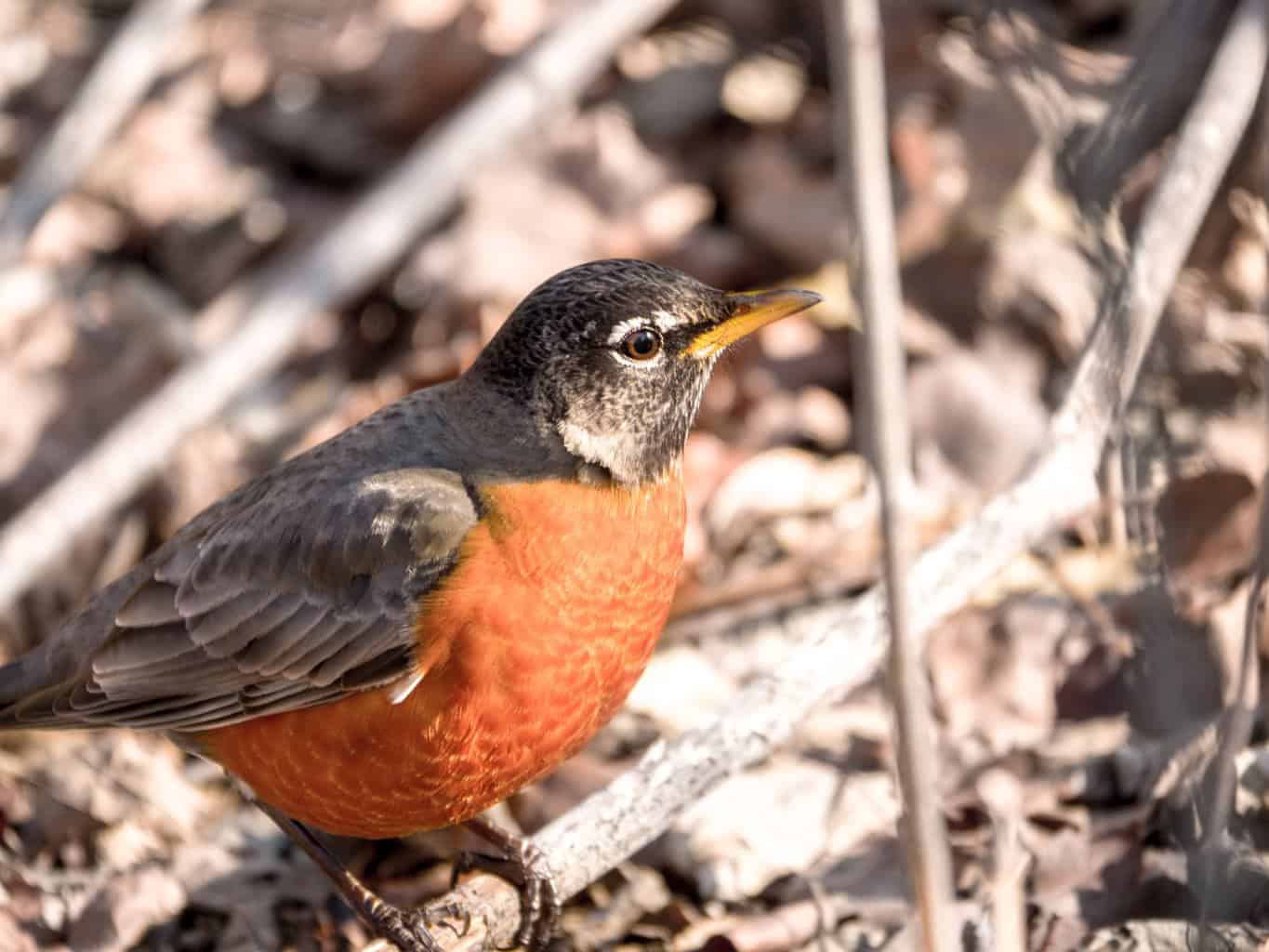
- Scientific Name: Turdus migratorius
- Length: 9.0 to 11.0 inches
- Weight: 2.3 to 2.8 ounces
- Wingspan: 14.7 to 16.5 inches
The American Robin is the state bird of Connecticut, as well as Wisconsin and Michigan. This migratory bird is one of the most common birds in these states and makes up the primary background ambiance in state parks.
This familiar bird belongs to North America’s wide range of thrush songbirds. Adult males have orange to reddish-orange breasts with dark black feathers on the neck, wings, and back. The male and female differ in body size. The female is usually smaller and thinner than the male.
When they breed, the female usually lays 3-5 beautiful, distinctive sky blue color eggs.
They’re known for singing their unique and beautiful song and will hang around your feeder freely during the early morning. they can be found in forests, backyards, and urban parks.
Varied Thrush

- Scientific Name: Ixoreus naevius
- Length: 7.5 to 0.2 inches
- Weight: 2.3 to 3.5 ounces
- Wingspan: 13.1 to 15.3 inches
Despite the resemblance between the Varied Thrush and the American Robin, this beautiful songbird is very different from its cousin.
Male Varied Thrushes also have an orange belly with a bluish-gray back. There is also a distinctive orange patch above the eyes and towards the ends of their wings. Females have less vibrant orange color but the same patterns.
While both robins and Varied thrushes sing beautiful songs, the latter are much more aggressive birds and territorial, so they fight off other birds to dominate bird feeders.
Black-Headed Grosbeak

- Scientific Name: Pheucticus melanocephalus
- Length: 5.9 to 7.8 inches
- Weight: 1.3 to 1.7 ounces
- Wingspan: 12.4 to 12.7 inches
The Black-headed Grosbeak is small to a medium-sized bird that also belongs to the same family as Northern Cardinals.
They’re identified by their brownish-orange breast and the black plumage all over their head, back, and tail. Their wings are another identifying aspect because they’re black with two distinct white markings.
Yellow Birds in Connecticut
American Goldfinch

- Scientific Name: Spinus tristis
- Length: 4.3 to 5.5 inches
- Weight: 0.39 to 0.71 ounces
- Wingspan: 7.5 to 8.7 inches
The American Goldfinch is one of the most common birds in Connecticut. The male of the species is known for its bright lemon yellow body with black wings and black forehead. Female American Goldfinches are usually paler in color and have no black spot on their heads. Summer birds are brighter than winter birds, which are pale yellow.
The American Goldfinch has a distinctive flying style that makes them easy to spot and identify. It’s also one of the easiest birds to attract to your backyard because you don’t even need a bird feeder to have them around.
All you have to do is scatter some seeds on the ground and they’ll come foraging. They also feed on different kinds of insects, so a feeder may not be necessary.
American Yellow Warbler

- Scientific Name: Setophaga petechia
- Length: 4.7 to 5.1 inches
- Weight: 0.3 to 0.4 ounces
- Wingspan: 6.3 to 7.9 inches
Warblers in North America are known for being mostly yellow. Yet, they’re also known for being extremely difficult to spot because they prefer foraging on the ground.
The adult bird has simple yellow plumage with a yellow belly, a faint olive-green back, and a yellow hood. Additionally, they have a large bill with no rings around the eye.
Your best chance of spotting the birds in summer is in poplar forests, spruce bogs, remote muskeg swamps, and lakes.
Yellow-Breasted Chat
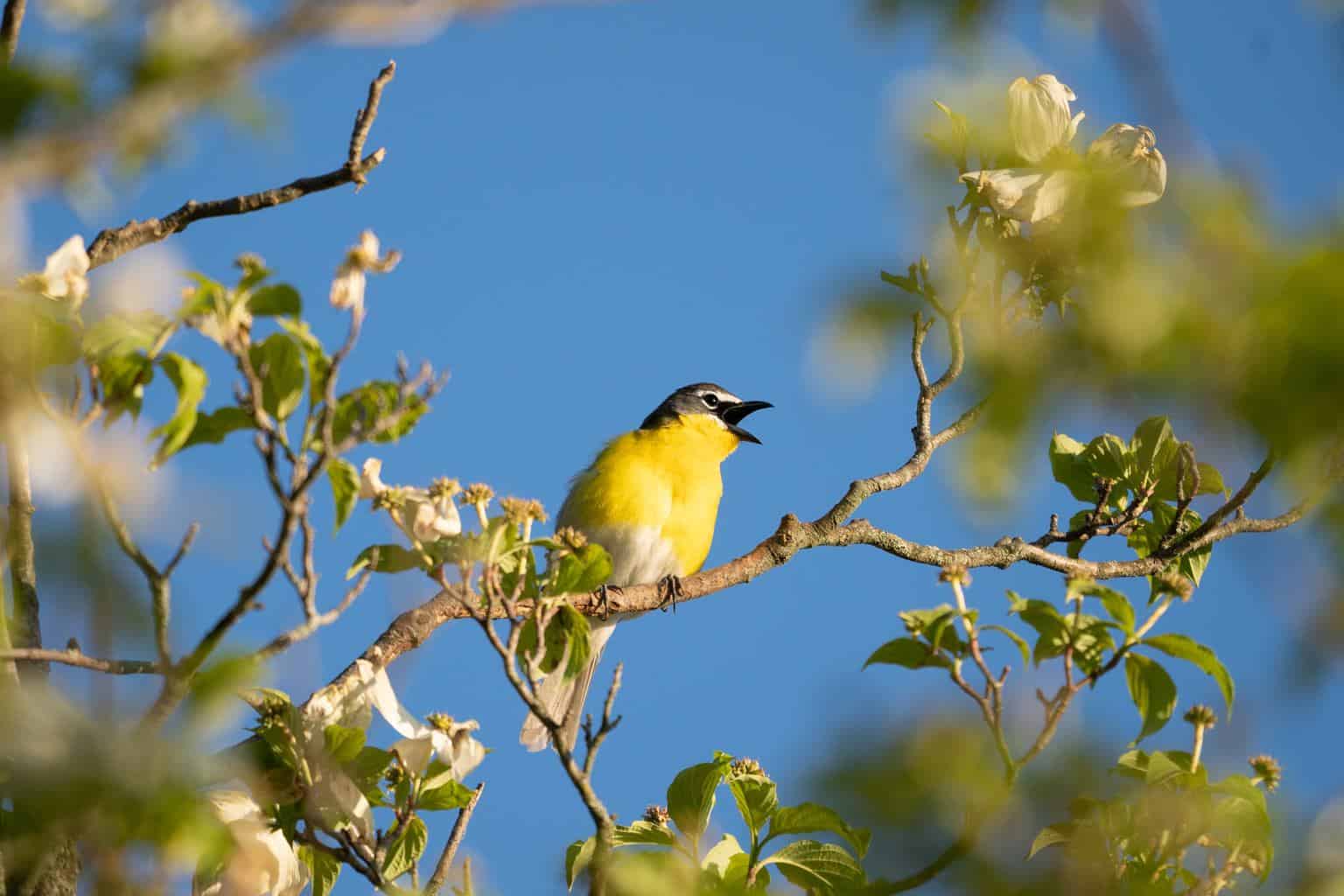
- Scientific Name: Icteria virens
- Length: 6.7 to 7.5 inches
- Weight: 0.7 to 1.19 ounces
- Wingspan: 9.0 to 10.6 inches
The yellow-breasted chat is a unique bird sporting a beautiful combination of yellow breast and olive-green back beautifully.
Back in the day, these birds used to be regular residents of Connecticut during the summer season.
This lasted until the late 40s of the last century when the yellow-breasted chat became an endangered species and is now only found in the southern regions of the state.
Yellow-Throated Vireo
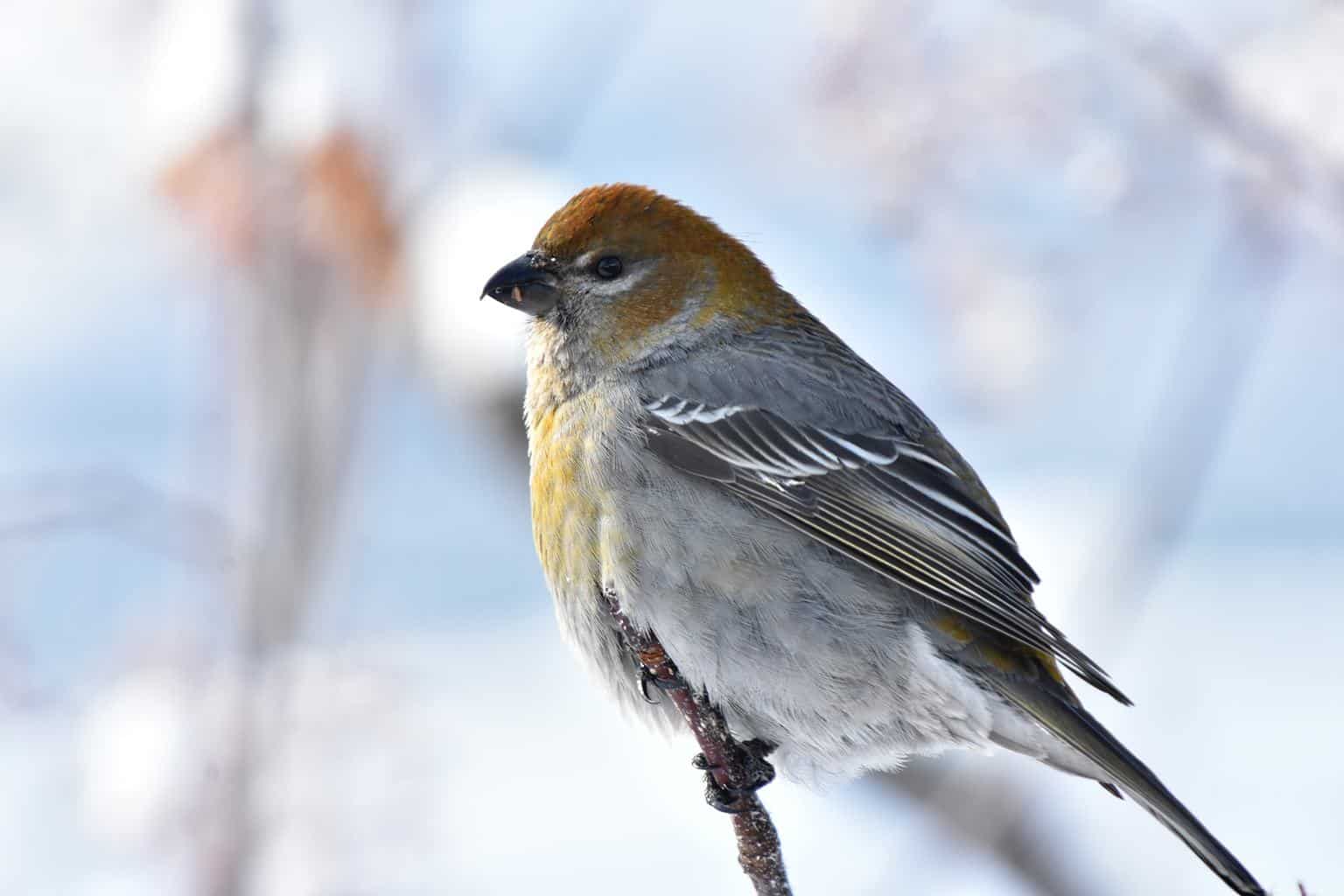
- Scientific Name: Vireo flavifrons
- Length: 5.1 to 5.8 inches
- Weight: 0.46 to 0.67 ounces
- Wingspan: 7.9 to 9.4 inches
Vireos are small, chunky, green passerine songbirds. However, one of the most prominent green vireos in Connecticut is the Blue-headed Vireo.
The Yellow-throated Vireo is easily identified by its canary yellow neck and chest, as well as a black streak from the beak to the eyes. This chest patch is brightest at the throat area, which is how they get their name.
Yellow-Rumped Warbler
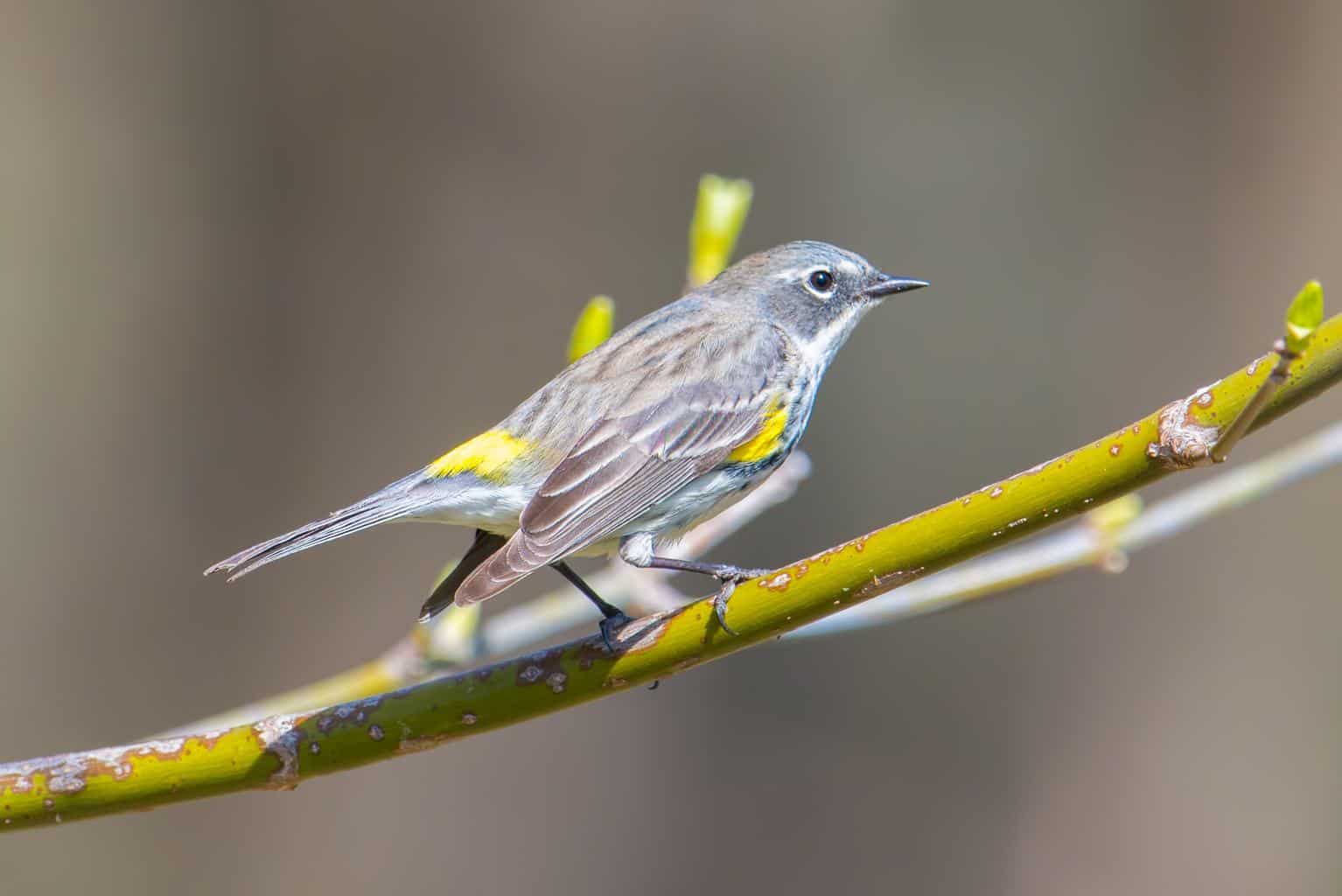
- Scientific Name: Setophaga coronata
- Length: 4.7 to 5.5 inches
- Weight: 0.4 to 0.5 ounces
- Wingspan: 7.5 to 9.1 inches
The yellow-rumped Warbler is one of the most unique birds in the state of Connecticut because it’s one of the few that changes its plumage according to the seasons.
They’ve earned their name due to their summer coat, which is mostly dark gray or black on the upper body, with several white patches on the wings and bright yellow feathers that cover their rump, face, and sides.
However, when the winter comes, their plumage changes to a paler brownish color. They’re more likely to visit your backyard during winter when they’re foraging for food. However, to see their bright yellow plumage, you have to look for them perching in trees.
Other Birds to Watch for In Connecticut
Mourning Dove

- Scientific Name: Zenaida macroura
- Length: 11.8 to 12.2 inches
- Weight: 4.3 to 6.4 ounces
- Wingspan: 17.3 to 18.2 inches
The Mourning Dove is one of the most common birds in Connecticut. They have buff or tan to pale brown plumage with various black spots which gives them the perfect camouflage and protection from predators. Male and female share a similar body shape.
However, it also makes it quite tricky to find one in its natural dense shrub habitat. They can be found just about everywhere; amusement parks looking for leftover food, captured by bird feeder cams, city parks, and in deep forests of deciduous trees. However, you can attract a flying Mourning Dove to your backyard if you have a bird feeder filled with millet and mixed seeds.
Purple Finch

- Scientific Name: Haemorhous purpureus
- Length: 4.7 to 6.3 inches
- Weight: 0.6 to 1.1 ounces
- Wingspan: 8.7 to 10.2 inches
Although this bird is named the Purple Finch, it’s mostly raspberry-colored with hues of purple that can only be noticed up close.
You can easily spot this common bird species in open woods while they’re foraging on the ground for insects, or on the trees perching.
Barred Owl

- Scientific Name: Strix varias
- Length: 16.9 to 19.7 inches
- Weight: 16.6 to 37.0 ounces
- Wingspan: 39.0 to 43.3 inches
Barred owls are not only commonly found in Connecticut but also in other eastern states, as well as Southern Canada.
They have plenty of features to help you identify them. However, the most distinctive one of them is the heart-shaped facial disk that they have.
You should keep in mind that this feature is also shared by Barn owls, but both of these owls look extremely different and you shouldn’t worry about mixing them up at all.
They have a grey body with reddish-brown markings and horizontal stripes that alternate between light and dark shades of brown. Additionally, they are among owls that have no ear tufts.
Red-Tailed Hawk
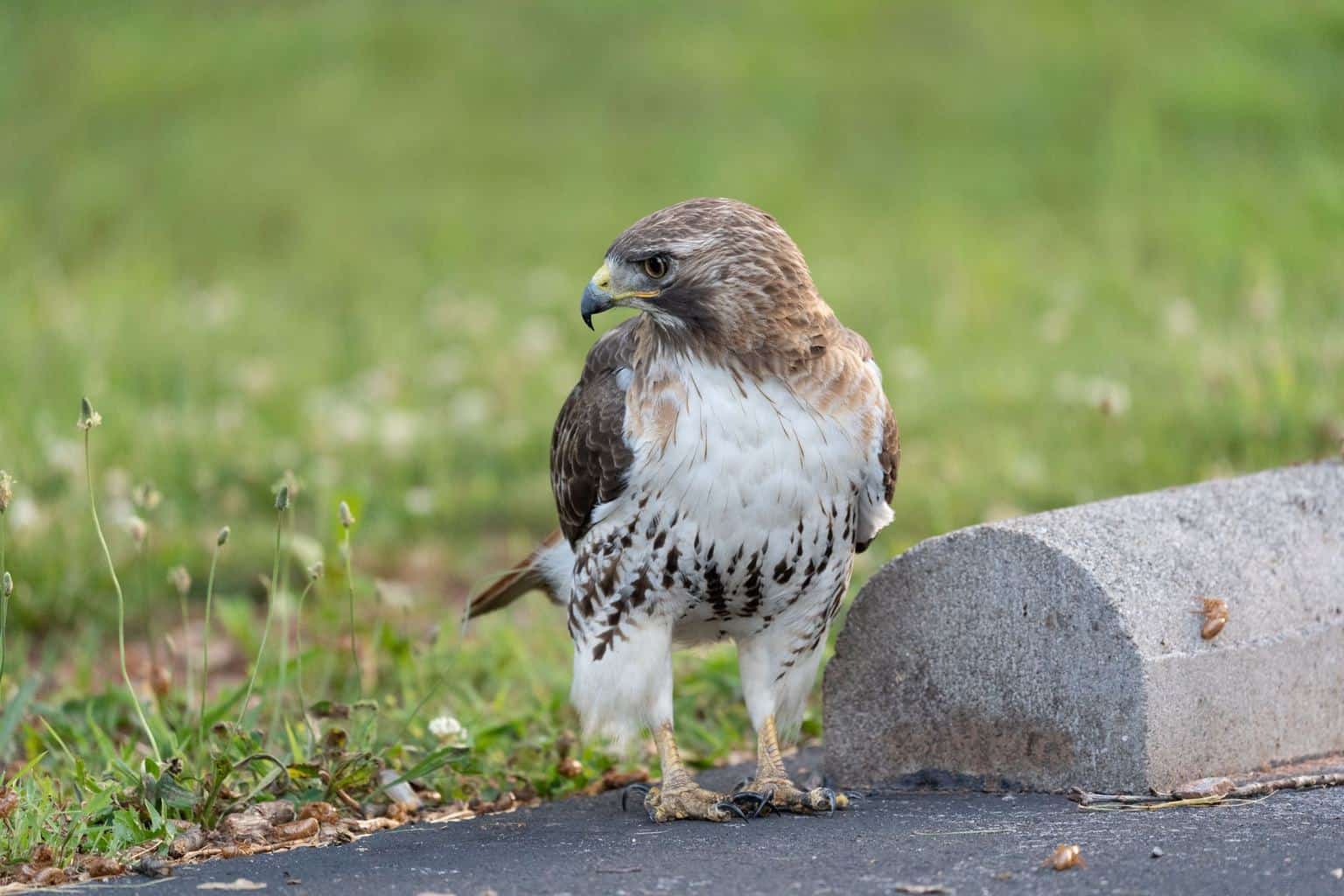
- Scientific Name: Buteo jamaicensis
- Length: 17.7 to 22.1 inches
- Weight: 24.3 to 45.9 ounces
- Wingspan: 44.9 to 52.4 inches
The Red-tailed hawk is one of the most common residents of Connecticut as well as neighboring states.
They’re known for living in woodlands and open country. The Red-tailed hawks’ diet is mainly composed of rodents as well as squirrels, snakes, and frogs, so they’re extremely essential for the balance of the ecosystem.
Purple Martin

- Scientific Name: Progne subis
- Length: 7.5 to 7.9 in
- Weight: 1.6 to 2.1 ounces
- Wingspan: 15.3 to 16.1 inches
The magnificently colored Purple Martin is one of the most unique native birds in Connecticut. They have a bluish-purplish color that is complemented with a dark gray plumage that makes the bird stand out as one of the most beautiful birds in the state.
Unfortunately, the bird’s numbers are in decline due to limitations of habitat and slow expansion into new areas. The bird species was downlisted by the state from endangered to a species of special concern.
American Crow
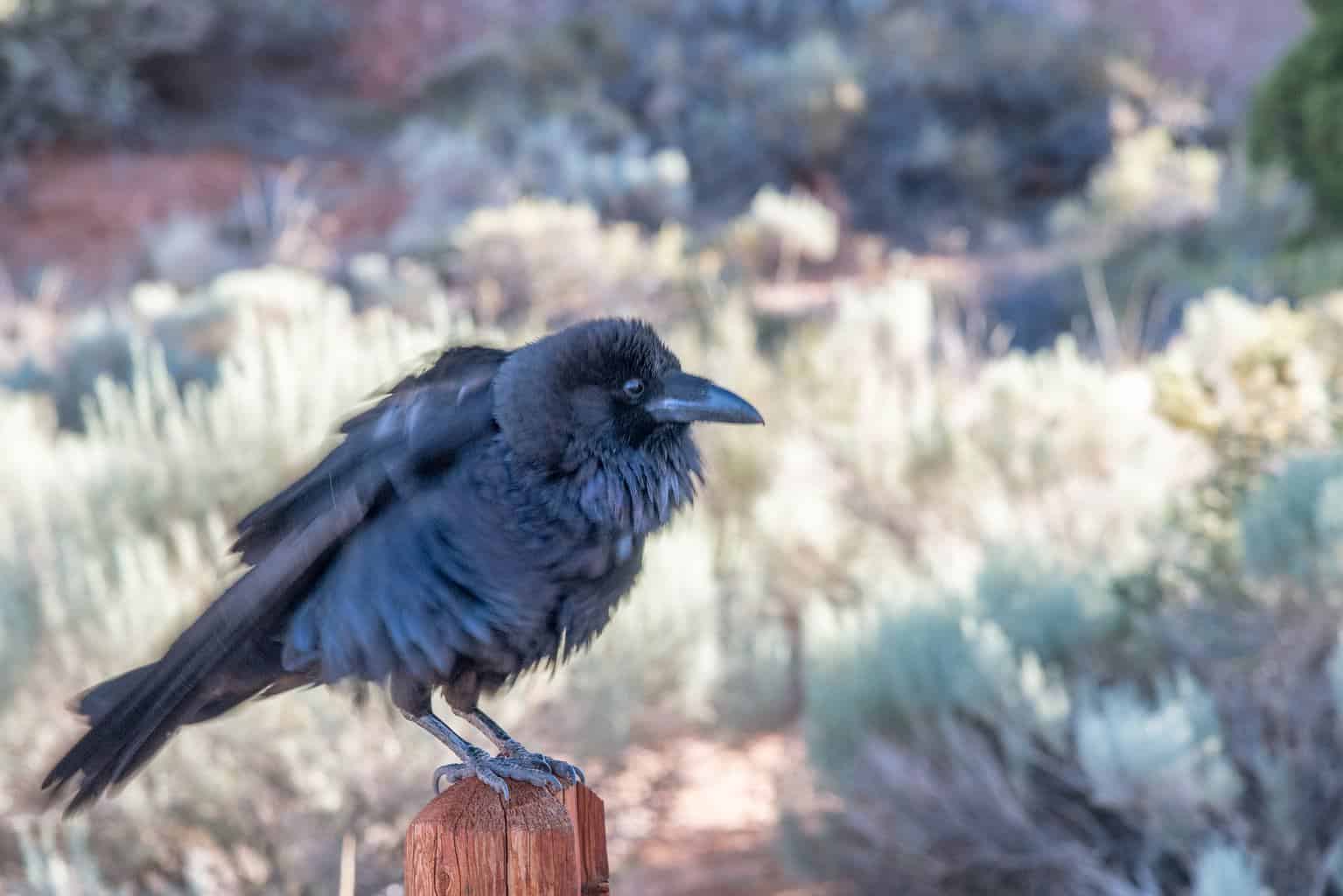
- Scientific Name: Corvus brachyrhynchos
- Length: 15.8 to 20.9 inches
- Weight: 11.2 to 21.9 ounces
- Wingspan: 33.5 to 39.4 inches
The American crow is one of the most off-beat, adaptable birds and has a huge cult following all over the country. It’s also one of the most common North American bird species. The familiar image of a crow hanging out in farm fields has been replicated innumerable times in the movies.
This medium size bird is one of the few birds that have a completely black plumage color from head to tail. Even the crow’s legs and bill are glossy-black in color.
Older crows and molted feathers might have a slight brown color, which is common among black crow species.
Wrap Up
There you have it! A complete guide about birds in Connecticut. As you can see, there’s no shortage when it comes to bird watching in the state. No bird-watching outing would be complete without spotting a few of these magnificent creatures. So grab your bird list and make sure that you always keep your bird feeder ready and your binoculars at hand!

